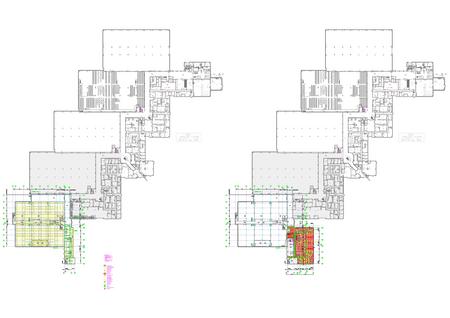As the record keepers of the Smithsonian’s past, our responsibilities include archiving information relating to the construction of Smithsonian museums themselves, and other building projects throughout the institution. Architectural plans for these jobs are primarily composed digitally using Computer Aided Design, or CAD, software. These born digital materials are eventually transferred to the Archives where the Digital Services Division is working on preserving them for long term use.
The Archives receives the majority of its CAD files in accessions from the Smithsonian’s Office of Facilities, Engineering, and Operations (OFEO). OFEO is in charge of building, operating, and maintaining all the Smithsonian facilities.

A previous intern with the Digital Services Division began working with CAD records last summer, and discussed the importance in preserving these records in a blog post about the architectural drawings and construction plans for the National Museum of the American Indian. She also noted the evolution of both CAD programs used to create the drawings, and the preservation methods that exist to maintain the records. Most of the drawings we have were produced using one of the CAD industry’s leading programs, and the native file format that the records were created in is not open and widely accessible. The files we have also range in date from 1995 to 2008, making it more of a challenge to preserve them since they were created with older versions of the CAD software that has continually undergone changes.

We continue to work with the architectural drawings of the National Museum of American Indian, which was completed in 2004, and also received new records documenting the 125,000 square foot addition to the Smithsonian’s Museum Support Center in Silver Hill, Maryland. The American Indian Museum has received a great deal of attention for its unique design, and the new storage and research wing at the Museum Support Center is known for its highly technical and complex structure. As a result, the files that the Archives received in conjunction with these projects were numerous, and extremely rich in detail.
This brings us to a few of the main issues being dealt with while trying to preserve these records. First is the issue of scale. In just one accession we received more than 1,200 CAD files, and more than 1,000 more in another. Second, the drawings are incredibly intricate, and constructed with several layers that are combined to produce one large file. When taking steps to preserve the drawings, one of our main goals is to maintain the visual integrity of the original, which has proved to be extremely difficult.
Additionally, the issue of access is being confronted through our work with these files. In our attempt to preserve these 2D architectural records, we have tried to convert the files into an open format that is both easily accessible, and long lasting. At this point in time, the evolving PDF/E format has been identified as the best possible solution to provide long-term access, but the majority of conversions have failed to produce quality results (PDF/E is an ISO, International Organization for Standardization, format intended for use in creation of documents in engineering workflows. This format allows easy exchange across multiple programs, and helps streamline the review and markup process for architects, engineers, and construction professionals). With the large number of files we have, working with each drawing individually is not an option, and so far batch conversions have unsuccessfully transferred the complex CAD information to the new format.

Current and future building projects throughout the Smithsonian will undoubtedly add more CAD files to the already large number that the Archives has. The ongoing renovation of the Arts and Industries Building and the construction of the National Museum of African American History and Culture (NMAAHC), scheduled to begin in 2012, are two major projects that will generate CAD records to be archived.
As is the case with most computer software, CAD programs are evolving and creating new processes that architects and engineers are using in their work. The plans for the NMAAHC will likely be executed using 3D modeling that is now standard with CAD software. This will present a whole new set of challenges and standards that the Digital Services Division and the Archives will continue to monitor and adapt to.
Produced by the Smithsonian Institution Archives. For copyright questions, please see the Terms of Use.

Leave a Comment